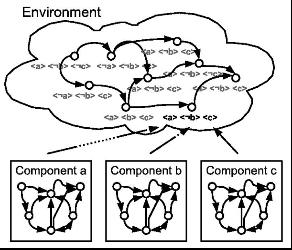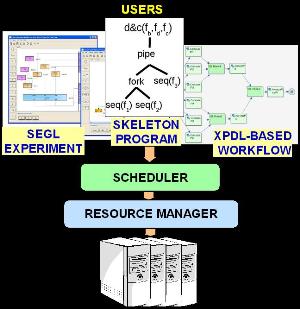Institute leader: Marco Danelutto (marcod di.unipi.it), University of Pisa di.unipi.it), University of Pisa |  | The institute on programming models aims to deliver a definition of a lightweight, component programming model that can be usefully exploited to design, implement and run grid applications. We will work on the hypothesis that the component based programming model's main aim is to efficiently face the new challenges in terms of programmability, interoperability, code reuse and efficiency that mainly derive from the features that are peculiar to GRID, namely, heterogeneity and dynamicity. GRID programmability, in particular, represents a big challenge. GRID programs cannot be written using normal programming models and tools, unless the programmer is willing to pay a high price in terms of programming, program debugging and program tuning efforts. In the design and implementation of the new component based programming model we will therefore try to move as much as possible these activities away from the programmer. The main goal of defining a lightweight, component programming model is split into different sub goals, namely: Roadmap version 3 on Programming Model | Definition of a programming model suitable for the implementation of the single component model Definition of the component system in such a way that interoperability with existing, commonly agreed standards is guaranteed Definition of a component composition such that complex, multidisciplinary applications can be written as composition of building block components, possibly obtained by suitably wrapping existing code. Component composition must support and guarantee that scalability is achieved Definition of clear component and component composition semantics allowing a user to prove the correctness of the transformation and/or improvement techniques derived and designed for the lightweight component model Definition of performance/cost models allowing the development of tools reasoning about component and component composition programs. | Publications related to the Institute on Programming Model WP3 Meeting in Paris, France
|
|
Research Group
| Leader
| Participants
| | Programming models of single components | EIA-FR | EIA-FR, INRIA, UNIPI, UNIPASSAU | | Component definition | INRIA | INRIA, UNIPI, VUA, IC, USannio | | Advanced programming models | UNIPI
| UNIPI, INRIA, WWU, UNIPASSAU, VUA, QUB, UPC, HRLS, ULisboa, USannio |
|
|
|
Latest Research Highlights |
Dynamic Reconfiguration of GCM components CoreGRID Technical Report TR-0173 [pdf]: We detail in this report past research and current/future developments in formal specification of Grid component systems by temporal logic and consequent resolution technique, for an automated dynamic reconfiguration of components. It is analysed the specification procedure of GCM (Grid Component Model) components and infrastructure in respect to their state behaviour, and the verification process in a dynamic and reconfigurable distributed system. Furthermore it is demonstrated how an automata based method is used to achieve the specification, as well as how the enrichment of the temporal specification language of Computation Tree Logic CTL with the ability to capture norms, allows to formally define the concept of reconfiguration. | 
| Towards a Spatio-Temporal sKeleton Model Implementation on top of SCA CoreGRID Technical Report TR-0171 [pdf]:
This report investigates an implementation of STKM, a Spatio-Temporal sKeletonModel. STKM expands the Grid Component Model (GCM) with an innovative programmable approach to compose an application by combining component, workflow and skeleton concepts. We explore a projection of the model on top of SCA and its implementation using Tuscany Java SCA. Experimental results show the need and benefits of the high level of abstraction offered by STKM. | 
| A Scheduler for a Multi-paradigm Grid Environment CoreGRID Technical Report TR-0155 [pdf]: Typical Grid environments are characterized by a two-level scheduling: super and local scheduling. While the former regards the selection of proper resources to execute high level tasks, the latter regards the scheduling of tasks to processors for optimizing performance and hardware exploitation. This paper proposes a super scheduler that provides services to domain specific high-level programming environments, while taking advantage of middleware libraries to handle the complexity of Grid computing. To prove the flexibility of the scheduler, three different programming environments with slightly different programming abstractions have been integrated with it: a problem solving environment (SEGL), a skeleton framework (Calcium) and a workflow enactment engine (SAWE). The integration above shows how it is possible to facilitate the adoption of the ProActive middleware for the development of complex Grid applications. | 
| |
|
|
|
 Institutes
Institutes  Institute on PM
Institute on PM